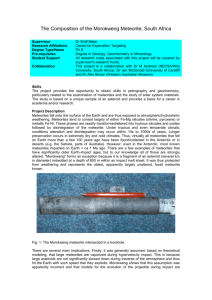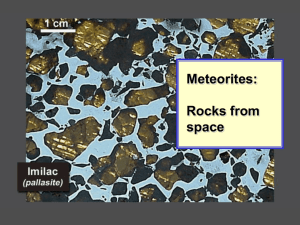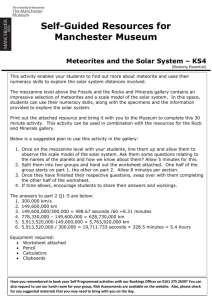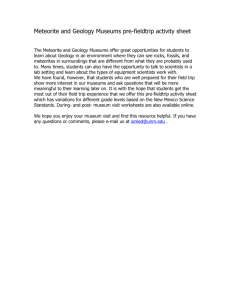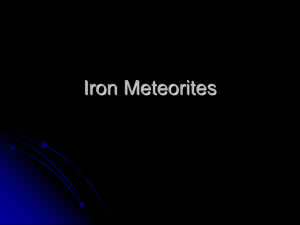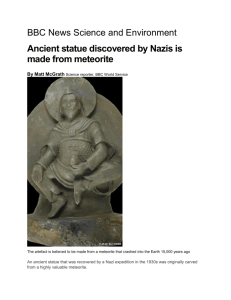week3_2009-meteorites
advertisement
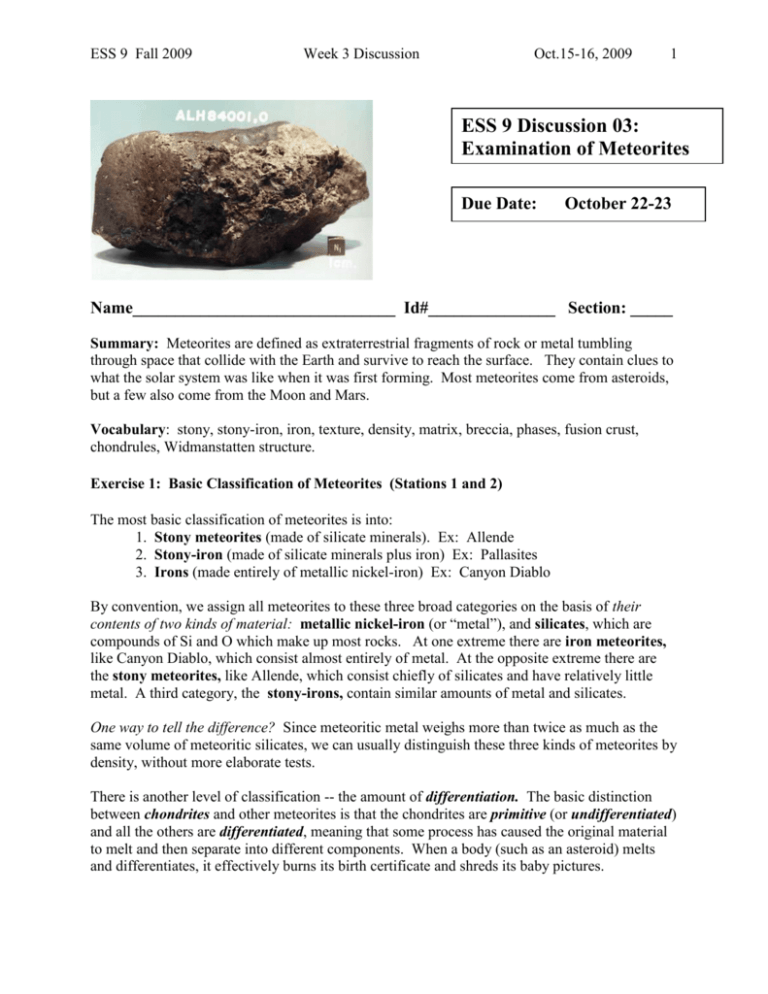
ESS 9 Fall 2009 Week 3 Discussion Oct.15-16, 2009 1 ESS 9 Discussion 03: Examination of Meteorites Due Date: October 22-23 Name_______________________________ Id#_______________ Section: _____ Summary: Meteorites are defined as extraterrestrial fragments of rock or metal tumbling through space that collide with the Earth and survive to reach the surface. They contain clues to what the solar system was like when it was first forming. Most meteorites come from asteroids, but a few also come from the Moon and Mars. Vocabulary: stony, stony-iron, iron, texture, density, matrix, breccia, phases, fusion crust, chondrules, Widmanstatten structure. Exercise 1: Basic Classification of Meteorites (Stations 1 and 2) The most basic classification of meteorites is into: 1. Stony meteorites (made of silicate minerals). Ex: Allende 2. Stony-iron (made of silicate minerals plus iron) Ex: Pallasites 3. Irons (made entirely of metallic nickel-iron) Ex: Canyon Diablo By convention, we assign all meteorites to these three broad categories on the basis of their contents of two kinds of material: metallic nickel-iron (or “metal”), and silicates, which are compounds of Si and O which make up most rocks. At one extreme there are iron meteorites, like Canyon Diablo, which consist almost entirely of metal. At the opposite extreme there are the stony meteorites, like Allende, which consist chiefly of silicates and have relatively little metal. A third category, the stony-irons, contain similar amounts of metal and silicates. One way to tell the difference? Since meteoritic metal weighs more than twice as much as the same volume of meteoritic silicates, we can usually distinguish these three kinds of meteorites by density, without more elaborate tests. There is another level of classification -- the amount of differentiation. The basic distinction between chondrites and other meteorites is that the chondrites are primitive (or undifferentiated) and all the others are differentiated, meaning that some process has caused the original material to melt and then separate into different components. When a body (such as an asteroid) melts and differentiates, it effectively burns its birth certificate and shreds its baby pictures. ESS 9 Fall 2009 Week 3 Discussion Oct.15-16, 2009 2 Chondrites, alone among the rocks that we can collect and study, carry a record of the first steps in the history of the solar system. Type Stony Stony-Iron Iron Example Sub-type Primitive vs. Differentiated Chondrite (e.g., Allende, Faucett) Primitive Eucrites (e.g., Millbillillie) Differentiated Pallasites (e.g., Esquel) Differentiated Nickel-Iron (Laguna Manantiales, Canyon Diablo) Differentiated Identifying characteristic Contain chondrules, CAIs, and/or metal flakes; medium density No chondrules; Basalt-like texture Equal amounts of metal and crystals intergrown Very dense; Widmannstatten patterns Activity: At Station One or Two you will find four meteorites. For one of them at each station, do the following: 1. Classify the meteorite into one of the three types. 2. Indicate if it is differentiated or undifferentiated. 3. Note the density (high, medium or low). 4. Also observe the texture, color and any inclusions you might see. Write down one complete sentence with a few observations. Some things to describe: 1. What are the meteorites? Are any chondrules visible? 2. Is there a fusion crust (an outer layer of the meteorite that melted during passage through the Earth’s atmosphere)? 3. The color(s) and texture (grainy, smooth, metallic) of the interior. 4. For the metallic meteorites, do you see a Widmannstatten pattern (the distinctive criss-cross crystallization seen in iron meteorites)? Station: #1. Type: _____________ Differentiated/Undifferentiated Density: High/Medium/Low Name: ___________________ Observations: ____________________________________________________________ ___________________________________________________________________________. #2. Type: _____________ Differentiated/Undifferentiated Density: High/Medium/Low Name: ___________________ Observation: ____________________________________________________________ ___________________________________________________________________________. ESS 9 Fall 2009 Week 3 Discussion Exercise 2: Terrestrial rocks Oct.15-16, 2009 (Station 3) Goal: To appreciate the uniqueness of meteorites, one first must have some familiarity with terrestrial rocks. At Station Three we have assembled some common/interesting rocks that can be easily found on Earth. Each rock is labeled with its rock type. Briefly examine each rock and pick 2 favorites and write the name of the rock next and some interesting characteristic. Exercise 3: Meteorites and “Meteor-wrongs” (Station 4) Goal: See if you can pick out which are the real meteorites. (This part will not be graded. For some of these, it could take an expert to see which is which! Just have some fun.) It is not always easy to distinguish between a meteorite and a terrestrial rock that looks like a meteorite, but is really a “meteor-wrong.” Some things to look for: Fusion Crust – a thin outer coat of smooth black/brown material. Density – an iron meteorite will be very dense (heavy). Magnetism – a meteorite can be somewhat magnetic to very magnetic. Banding, stratification – a meteorite will not show any sedimentary layering structures. 5. Granitic texture – a primitive meteorite will not have intergrown crystals (like granite does.) 1. 2. 3. 4. To do: There are three meteorites among the meteor-wrongs. See if you can identify at least two of them. Write the rock’s ID number, what type you think it is, and why you think it is a meteorite. Meteorite #1 : ID# ________ Type: _____________ Why I think it is a meteorite: ___________________________________________________ 3 ESS 9 Fall 2009 Meteorite #2 : Week 3 Discussion ID# ________ Oct.15-16, 2009 4 Type: _____________ Why I think it is a meteorite: ____________________________________________________ _____________________________________________________________________________. Exercise 4: Thin section (Station 5) A thin section is a piece of rock that has been sliced so thin that light can pass through. We have set up four petrographic microscopes that allow you to look at actual thin sections, three of meteorites and one of a terrestrial rock containing the mineral olivine (which is also a common mineral in chondrules). In this section simply admire the thin sections and describe (briefly) one thin section of your choice (what colors do you see, shapes of the minerals, etc.). Thin section observation: ________________________________________________________ ____________________________________________________________________________. ____________________________________________________________________________.

